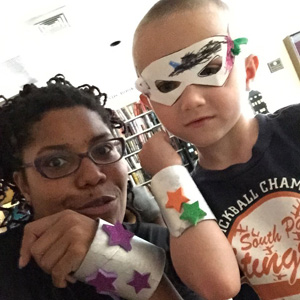 Graphic novels are often overlooked, dismissed even, when people come into our library. On more than one occasion, I have overheard a parent dismiss a book as nothing but a silly comic book and steer their child towards something they deem more acceptable. I will admit I was one of those parents. Graphic novels and comic books seemed too busy for me to follow, so when my daughter would look for a book to read, eventually selecting a graphic novel or comic book, I would pair her picks with “regular” novels. After being introduced to some wonderful titles through a former library vendor, I changed my opinion about comic books in general and have been looking for ways to share this revelation ever since.
Graphic novels are often overlooked, dismissed even, when people come into our library. On more than one occasion, I have overheard a parent dismiss a book as nothing but a silly comic book and steer their child towards something they deem more acceptable. I will admit I was one of those parents. Graphic novels and comic books seemed too busy for me to follow, so when my daughter would look for a book to read, eventually selecting a graphic novel or comic book, I would pair her picks with “regular” novels. After being introduced to some wonderful titles through a former library vendor, I changed my opinion about comic books in general and have been looking for ways to share this revelation ever since.
Each summer, my library system is a part of the Collaborative Summer Library Program, a consortium of states working together to provide high-quality summer reading program materials for children, tweens, teens, and adults with a theme for children. The theme for 2015 is “Every Hero Has a Story,” which led to the creation of Superhero Reads at our library. Superhero Reads was originally to be a book discussion group for tweens, ages 8–11, to discuss books featuring heroes. The library would provide a list of titles from which the students would choose, and they would read the books on their own. During our weekly meetings, we would discuss our books. This would allow students the opportunity to share what they are reading, practice public speaking and expressing themselves, and introduce titles that may otherwise go unread.
The plans I made were abandoned after the first meeting. The group of students who showed up for the initial meet up ranged from ages 5–12, and the range of books being discussed was so broad that some of the children wanted to leave the first meetup.
The name of the program confused some of the members, because they thought a superhero was coming to read to them. Once we explained that THEY were creating their own heroes, the children were excited to get to work. As we started the ice-breaker activities, some of the students needed more encouragement than others to share their favorite hero traits and what book they were reading, and the format was altered to accommodate the attendees.
There was a discussion about favorite heroes, what makes a person a hero, and what’s in a name. Using an online tool to generate names, we created the ultimate superhero name and then we wrote backstories. Children were encouraged to read what they wrote in a judgment-free space. Feedback and suggestions were offered to those students who were struggling. Some participants created original characters whereas others went with established characters. Although some of the stories were familiar, there also were some unique additions that made familiar characters fun and fresh.
What good is a hero without a nemesis? So we created some.
I had found that many children were reluctant to share, worrying that their creation was not “right,” but I show them some of my artwork—which only can be described as horrible—to put them at ease and to demonstrate that everyone struggles, but that is not a reason not to try.
Supplies for these creations included paper, pencils, color pencils or crayons, books (which we got from the library), and a place to meet. My library owns a machine to make spiral bound books but we could easily substitute rings or use a binder, so costs were kept to a minimum.
The range of backstories were so much fun that for a moment one student said that he wished that he could be a supervillain (me too!). We flushed out characteristics for the villains. The students who were further along created logos and costumes for their characters. The first meeting seemed to be the most diverse with age and ability, and subsequent meetings found different students attending throughout the run of the program. We discuss what makes a hero, offered scenarios in which our hero may be confronted with unheroic behavior, and choices the hero should make. We talk about unlikely villains. We share artwork which may or may not be perfect. We have fun.
The final product is currently in production. We are combining the art and stories we have created into a graphic novel each student will receive at the end. Some stories are more complete than others, which is just fine. The idea was to encourage imagination, exploration, and to put to rest the words “I can’t.”
Resources to start your own graphic novel discussion group
 Rachee Fagg is the children’s librarian at the Lansdowne Public Library in Lansdowne, PA.
Rachee Fagg is the children’s librarian at the Lansdowne Public Library in Lansdowne, PA.